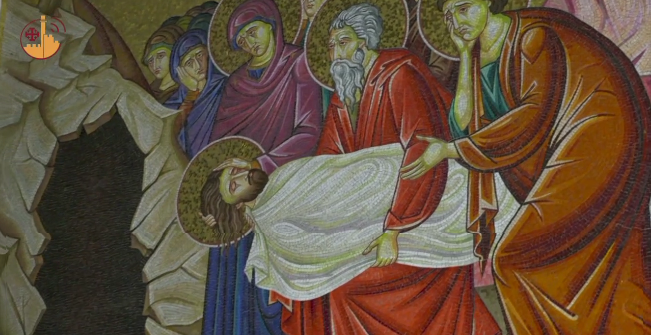Every day, the shrines of the Holy Land welcome pilgrims from all over the world.
Mystical places where the grace of Revelation is experienced.
The Custody of the Holy Land has the task of preserving more than 50 sanctuaries, located in the current borders of Israel, Palestine and Jordan.
From Mount Nebo, where Moses contemplated the Promised Land…
…to the sanctuaries of Jesus’ life, passion and death.
Jerusalem is considered the heart of the Holy Land.
On the Mount of Olives, the Sanctuaries of the Passion: Jesus’ weeping and wailing over Jerusalem are commemorated in the Church of Dominus Flevit, which offers one of the most beautiful views of the Holy City.
A few meters below, next to the garden of olive trees, is the Basilica of Gethsemane, the place of Jesus’ agony.
Early in the morning, Br. Benito opens the doors to receive hundreds of pilgrims. He says: “the first image I see every morning is the Golden Door, the Walls of Jerusalem”.
Br BENITO JOSÉ CHOQUE, ofm
Guardian of the Basilica of Agony
“We Franciscans of the Custody of the Holy Land preserve with much love these eight olive trees planted in memory of the Lord’s agony. In recent years, there have been many reservations and visits to the Holy Places. Gethsemane is one of the most loved places by pilgrims. There are many celebrations of Holy Masses, just as there are many prayers of Christians but also of those who are not Christians.”
Inside the Walls of Jerusalem, pilgrims follow the 14th Stations of the Cross. A practice which started with the Franciscans in 1600 and which is repeated every Friday until today.
Christians see one heart in Jerusalem: the Basilica of the Holy Sepulchre, where the place of Calvary and the Tomb of Christ are located. It is precisely in this holy place where you can see the growth in the number of pilgrims.
Br SALVADOR ROSAS FLORES, ofm
President of the Convent of the Basilica of the Holy Sepulchre
“This growth in the number of pilgrims has been happening since I’ve been here, for 2 and a half years. I can say that since that time the numbers have multiplied… and they don’t seem to decrease. The long queues, masses, the presence of pilgrims and tourists is continuous, constant and always crowded.”
Br SALVADOR ROSAS FLORES, ofm
President of the Convent of the Basilica of the Holy Sepulchre
“In this Basilica there is a rule, which is the Status Quo, whereby the three communities that live there, that is, we Catholics, the Greek Orthodox, and the Armenian community, have precise common spaces like the Tomb and Calvary. Here we can celebrate in turns. When it is our turn, we provide the pilgrims with their masses, especially in the morning, very early”.
Very early means at 4 am when the three communities together open the Basilica. Masses in the commonplaces begin at 4.30 a.m. followed by celebrations for the pilgrims in the different chapels. Everything is prepared for the celebrations; the missal is also available in different languages.
Br SALVADOR ROSAS FLORES, ofm
President of the Convent of the Basilica of the Holy Sepulchre
“So, in one day we have more than 20 masses.”
Br SALVADOR ROSAS FLORES, ofm
President of the Convent of the Basilica of the Holy Sepulchre
“The Holy Sepulchre is always open to everyone from morning till night. Pilgrims, tourists, all those who wish to see the Holy Sepulchre, touch the Tomb and all those who want to experience the grace of the Risen Lord”.
From the data of the Christian Information Center, which only concerns groups that book masses in the sanctuaries, it is possible to see the numbers of the impressive growth: in 2018, 14,650 groups booked masses, compared to 16,490 in 2019. Last November, 7,356 Masses were celebrated in the Shrines.
The Franciscan presence in the Holy Land dates back to 1217, with the arrival of the first Franciscans: a presence confirmed by documents issued by the popes over the centuries.
Br NARCYZ KLIMAS, ofm
Professor of ecclesiastical history
“Officially, we begin in 1342 with the famous Bull Gracias Agimus, issued in Avignon by Pope Clement VI, in which the friars are named as custodians of the holy places. The friars from all the countries of the world were to belong to the custody, which was to be an international community”.
Not only were the juridical foundations for the safeguarding of the holy places laid with the Bull, but they were also charged with maintaining and helping the Friars the Royalty of Naples, to whom the other Bull of Clement VI, Nuper Carissimae, was addressed.
In the archives of the Custody, there are the Bull of Pope Martin V, issued by Mantua in 1421, the documents dated 1746 of Pope Benedict XIV, and the reconfirmation of the mandate by Pope Pius IX in 1846.
Br NARCYZ KLIMAS, ofm
“In recent times we have, among the most recent documents, one of the most important ones: that of Pope Paul VI, Nobis in Animo, who confirms the protection of the holy places by the friars and their right to do this fundraising to maintain the holy places. It was the year 1974, and after that, there would be the confirmation of the various Popes who came to the Holy Land, from John Paul II to Benedict XVI, up to Pope Francis”.
“This land is loved and desired by many. All of us are called to guard it, protect it and feel it as ours. It is at the origin of our culture, history, religion… For this, we need the support of everyone!”.
Br Francesco Patton, ofm
Custos of the Holy Land
View the video: https://cmc-terrasanta.com/en/media/easter/19499/to-preserve-memory-and-update-the-history-of-redemption


